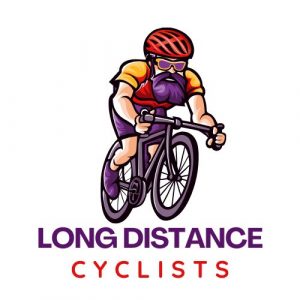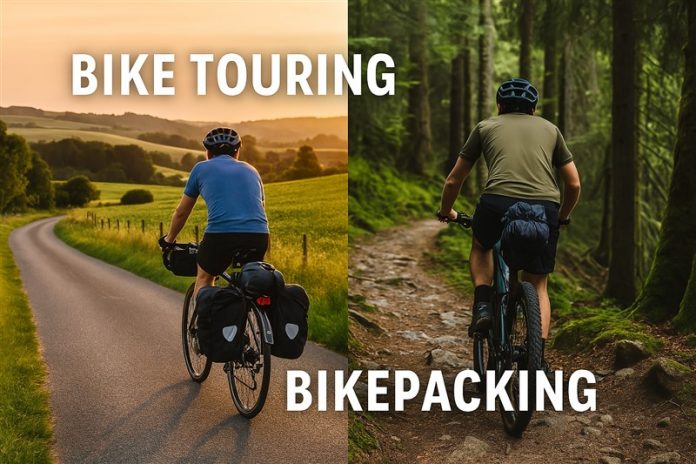Introduction
Long-distance cycling continues to grow in popularity, offering freedom, adventure, and personal challenges on two wheels. Whether you’re dreaming of pedalling through mountain passes or rolling through quiet country lanes, two styles dominate the adventure cycling landscape—bike touring and bikepacking. Both appeal to those seeking multi-day cycling trips, but they differ in gear, terrain, and overall approach. In this guide, we’ll explore the key differences between bike touring and bikepacking to help you decide which style suits your next cycling adventure.
What is Bike Touring?
Bike touring is a style of cycling where riders travel long distances, often over several days or weeks, carrying their own gear and supplies. Typically done on paved roads or light gravel, bike touring is built around comfort, stability, and self-reliance.
Key Characteristics of Bike Touring
- Primarily on paved roads or established bike routes
- Uses traditional touring bikes with panniers and racks
- Focuses on sightseeing, travel, and comfort
- Often includes staying in campsites, hostels, or hotels
- Ideal for road cycling enthusiasts who enjoy structured trips
Ideal Scenarios for Touring
Bike touring is perfect for riders who enjoy smooth roads, scenic routes, and carrying more gear with them. It’s often chosen for longer cross-country or international journeys where access to amenities is more predictable.
What is Bikepacking?
Bikepacking is a more recent evolution in long-distance cycling, influenced by the minimalist ethos of backpacking. It typically involves riding on mixed terrain—dirt roads, singletrack, and trails—using lightweight bags mounted directly to the bike frame, rather than racks and panniers.
Key Characteristics of Bikepacking
- Focus on off-road or mixed terrain
- Uses gravel bikes, hardtail MTBs, or adventure bikes
- Gear packed in frame bags, seat packs, and handlebar rolls
- Emphasizes minimalist packing and self-sufficiency
- Often involves wild camping or remote locations
Ideal Scenarios for Bikepacking
Bikepacking is best for those who enjoy adventure and solitude and want to ride far from busy roads and into nature. If you prefer singletrack trails, forest paths, or remote gravel routes, bikepacking is likely your ideal discipline.
Comparing Bike Touring vs Bikepacking
Below is a detailed comparison of key aspects:
| Feature | Bike Touring | Bikepacking |
|---|---|---|
| Terrain | Paved roads, bike paths | Gravel roads, trails, mixed terrain |
| Bike Type | Touring bike, road bike with racks | Gravel bike, MTB, adventure bike |
| Gear Setup | Panniers, racks | Frame bags, seat packs, handlebar rolls |
| Load Capacity | Higher load (more gear) | Minimalist load (less gear) |
| Comfort | More upright geometry, stable ride | Lighter setup, agile handling |
| Navigation | Typically easier with GPS or paper maps | Requires detailed planning, possible off-grid |
| Accommodation | Hotels, hostels, organized campsites | Wild camping, bivvying, remote stops |
| Best For | Road-focused travel, comfort, long distances | Adventure, solitude, off-grid exploration |
| Popular Destinations | EuroVelo routes, Pacific Coast, etc. | Baja Divide, Colorado Trail, Highland Trail 550 |
Pros and Cons of Bike Touring
Pros
- More storage space and comfort
- Easier access to towns and facilities
- Ideal for beginners and long-distance road travel
Cons
- Heavier and bulkier setup
- Less agile for off-road conditions
- Can be more expensive due to gear and accommodations
Pros and Cons of Bikepacking
Pros
- Lighter and more agile setup
- Access to remote, wild areas
- Encourages minimalism and creativity
Cons
- Less storage capacity
- Requires more planning and resilience
- Not ideal for heavily paved or urban routes
Choosing the Right Style for You
Your choice between bike touring and bikepacking depends on your goals, experience, and the kind of adventure you seek. If you’re new to long-distance cycling and prefer well-traveled routes with infrastructure, touring might be the better fit. If you’re drawn to remote trails, lightweight gear, and rugged terrain, bikepacking offers an exciting challenge.
Ask Yourself:
- Do I want to ride off-road or stick to paved roads?
- How much gear do I need to carry?
- Am I comfortable camping in remote areas?
- Do I prioritize comfort or adventure?
Recommended Bikes and Gear
Touring Setup
- Bike: Surly Long Haul Trucker, Trek 520
- Gear: Rear/front racks, Ortlieb panniers, Brooks B17 saddle
- Extras: Mud Guards/Fenders, handlebar mirror, dynamo lights
Bikepacking Setup
- Bike: Salsa Fargo, Specialized Diverge, Cannondale Topstone
- Gear: Apidura or Revelate Designs bags, lightweight sleeping kit
- Extras: GPS tracker, solar charger, water filter
Training and Preparation
Regardless of your chosen style, preparation is key. Begin with shorter rides to test gear and build endurance. Learn basic bike maintenance, navigation, and how to pack efficiently. Joining local cycling clubs or online communities can also help you connect with other long-distance riders.
Join the Community at LongDistanceCyclists.com
We’re building a global hub for adventure cyclists like you. Whether you’re preparing for your first tour or planning an epic bikepacking trip, LongDistanceCyclists.com has you covered with:
- Beginner guides and gear reviews
- Rider stories and trip inspiration
- Forums to connect with fellow cyclists
- Events calendar for tours, brevets, and gravel rides
Comment on this article or share your long distance cycling experiences in our comment section below and connect with other endurance riders worldwide.
Final Thoughts
Both bike touring and bikepacking offer incredible opportunities to explore the world under your own power. Whether you’re cruising coastal roads or navigating rugged trails, long-distance cycling provides a deeply rewarding way to travel. Choose the path that matches your personality, goals, and riding style—and get ready for the ride of a lifetime.
👉 Ready to start your journey? Subscribe to our newsletter and begin planning your first big ride.











Good article! I prefer bike touring, as I am more of a road rider.
Thank you. Your feedback is very much appreciated 🙂